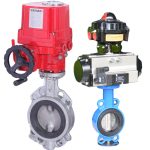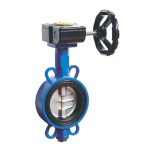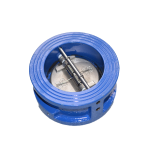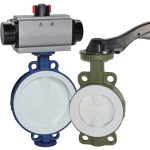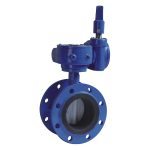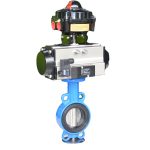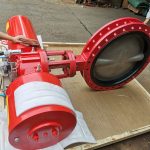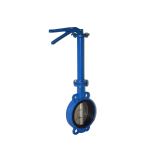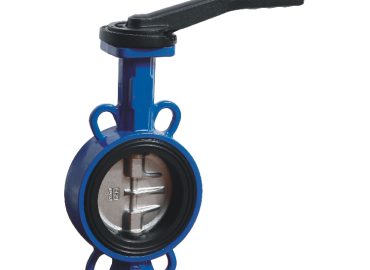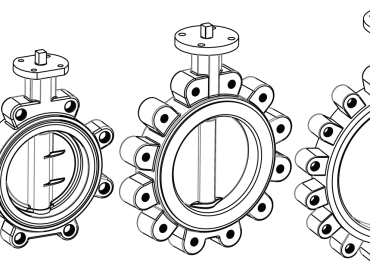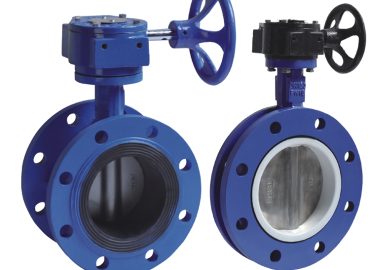Selecting the right valve for a specific application is crucial to ensure the efficiency and longevity of a system. Butterfly valves and gate valves, two of the most commonly used types of valves, each have their unique advantages and applications. In this blog post, we will dive into the world of butterfly and gate valves, exploring their distinct features and identifying the various applications best suited for each. By understanding the characteristics and ideal use cases of these valves, you can make informed decisions when designing or maintaining your fluid control systems.
Introduction
Butterfly valve and gate valve serve different purposes in a wide range of applications, each offering unique benefits and features that make them ideal for specific scenarios. Butterfly valves are best suited for applications that require throttling and flow control, such as water, air, and gas systems, including HVAC systems. Their compact design, cost-effectiveness, quick operation, and minimal maintenance requirements make them an excellent choice for industries like food and beverage processing and chemical plants. On the other hand, gate valves excel in providing precise flow control with minimal pressure drop, making them perfect for high-pressure applications and various types of fluids. They are commonly used in the oil and gas industry, water and sewage treatment plants, power generation plants, high-pressure steam systems, and mining and mineral processing operations. When choosing between these two types of valves, it is essential to consider factors such as pressure and temperature requirements, fluid type and properties, space constraints, budget, and overall maintenance needs. By understanding the distinct characteristics and ideal applications of butterfly and gate valves, you can ensure optimal performance and longevity for your fluid control systems.
Brief overview of butterfly valve and gate valve
Butterfly valve and gate valve are two common types of valves used to control the flow of fluids in various systems. Butterfly valves consist of a rotating disc mounted on a shaft, which is used to regulate or stop fluid flow by pivoting the disc to open or close the valve. They are known for their compact design, cost-effectiveness, quick operation, and minimal maintenance requirements. Gate valves, on the other hand, feature a sliding gate that moves vertically to open or close the valve, providing precise flow control with minimal pressure drop. These valves are suitable for high-pressure applications and can handle various types of fluids, making them popular in industries such as oil and gas, power generation, and water treatment. Both butterfly and gate valves offer unique advantages that make them ideal for specific applications, and understanding their distinct features can help in selecting the right valve for your fluid control needs.
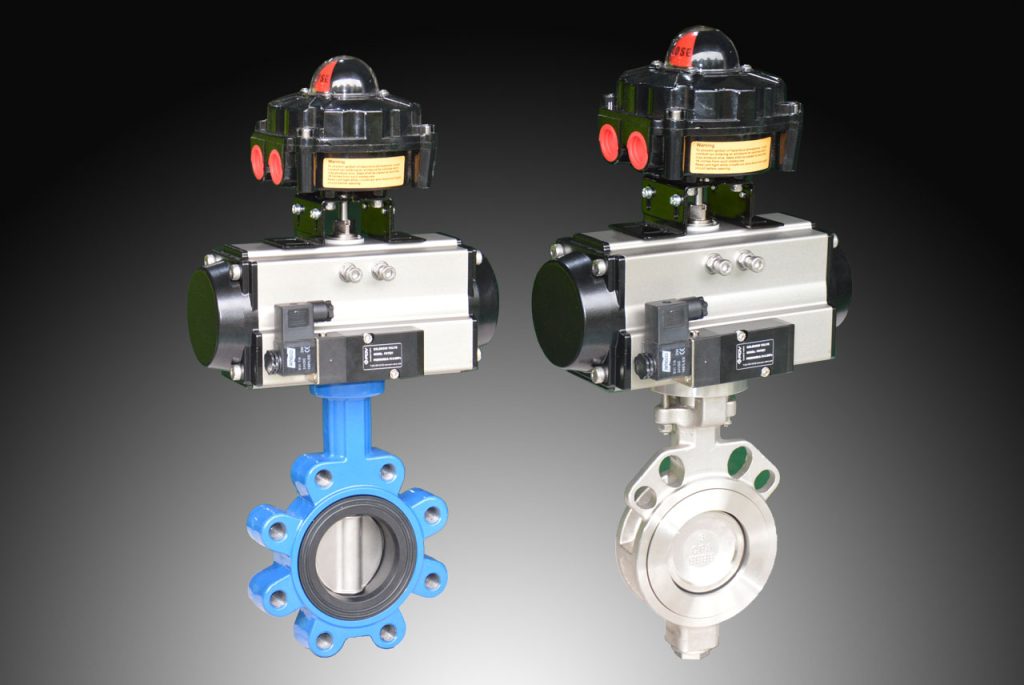
Importance of selecting the right valve for specific applications
Choosing the appropriate valve for a specific application is crucial to ensure the efficient functioning, safety, and longevity of a fluid control system. Selecting the right valve can significantly impact the overall performance of the system, as it directly influences the flow regulation, pressure management, and fluid handling capabilities. Furthermore, using a valve that is not suited for a particular application can lead to increased maintenance costs, premature wear, potential leaks, or even system failures. By understanding the unique characteristics and advantages of different types of valves, such as butterfly and gate valves, you can make informed decisions when designing or maintaining your fluid control systems, ultimately optimizing performance, reducing downtime, and prolonging the life of your equipment.
Help readers understand the best suited applications for butterfly valve and gate valve
The objective of this blog post is to provide readers with a comprehensive understanding of butterfly valve and gate valve, their unique features, and the applications best suited for each type. By exploring the advantages and ideal use cases of these two popular valve options, we aim to help readers make informed decisions when selecting valves for their fluid control systems. With a thorough knowledge of the characteristics and specific applications of butterfly and gate valves, readers can optimize their system performance, enhance safety, and minimize maintenance costs, ensuring the efficient operation and longevity of their fluid control equipment.
Understanding Butterfly Valves
Butterfly valve are a versatile and widely used type of valve that control the flow of fluids in various systems. They consist of a disc mounted on a shaft, which can be rotated to open or close the valve, effectively regulating the flow of the fluid. One of the key advantages of butterfly valves is their compact design, making them ideal for applications where space constraints are a concern. Additionally, they are cost-effective, offering an economical solution for flow control without compromising on performance. Butterfly valves are also known for their quick operation, as the disc can be rotated with minimal effort, allowing for rapid opening and closing of the valve. This feature makes them well-suited for applications requiring frequent adjustments or emergency shut-offs. Furthermore, butterfly valves generally require minimal maintenance, as their design reduces the chances of leaks and wear over time. With their unique combination of features, butterfly valves are widely used in industries such as water treatment, HVAC systems, food and beverage processing, and chemical plants, offering efficient and reliable flow control solutions for a variety of applications.

Definition and basic functionality of butterfly valves
Butterfly valves are a type of quarter-turn valve that regulate the flow of fluids in various systems. They consist of a flat, circular disc mounted on a shaft, which is positioned perpendicular to the fluid flow. The basic functionality of a butterfly valve involves rotating the disc around the shaft to open or close the valve. When the disc is parallel to the flow, the valve is fully open, allowing fluid to pass through with minimal obstruction. Conversely, when the disc is rotated 90 degrees and becomes perpendicular to the flow, the valve is fully closed, effectively stopping fluid flow. Butterfly valves offer a compact design, quick operation, and cost-effective flow control solution, making them ideal for a wide range of applications across multiple industries.
Components of a butterfly valve
A wafer butterfly valve comprises several key components that work together to regulate fluid flow in a system. The most prominent component is the circular disc, which serves as the primary flow control element. The disc is connected to a shaft, which allows for rotation and precise positioning of the disc within the valve body. The valve body itself is usually designed with a short face-to-face dimension, providing a compact and space-saving solution. To ensure a tight seal when the valve is closed, an elastomeric or resilient seat is often incorporated into the valve body, surrounding the disc’s perimeter. In addition, butterfly valves are equipped with a manual or automated actuator, which facilitates the rotation of the shaft and disc, enabling precise control of the flow. The actuator can be a simple lever handle for manual operation or a more sophisticated pneumatic, electric, or hydraulic system for automated control. Together, these components make up a butterfly valve, offering a reliable and efficient flow control solution for various applications.
Advantages of using butterfly valves
Butterfly valves offer numerous advantages that make them a popular choice for flow control in various systems. One of their key benefits is their compact design, which requires minimal space for installation, making them ideal for applications with limited room. They are also lightweight compared to other valve types, making them easier to install and handle. In addition, butterfly valves are known for their cost-effectiveness, providing efficient flow control at a lower price point than many other valves. Their quick operation is another advantage, as the disc can be rotated with minimal effort, allowing for rapid opening and closing of the valve. This feature is particularly useful in situations requiring frequent adjustments or emergency shut-offs. Butterfly valves also have low-pressure drops when fully open, ensuring minimal impact on the system’s overall pressure. Furthermore, they typically require less maintenance due to their simple design and minimal internal parts, reducing the likelihood of leaks and wear over time. Lastly, butterfly valves are versatile and can be used with various types of fluids, including liquids, gases, and slurries, making them suitable for a wide range of industries and applications.

Applications Best Suited for Butterfly Valves
Butterfly valves are well-suited for a diverse range of applications across various industries, thanks to their unique combination of features and benefits. In water treatment facilities, butterfly valves are commonly used for controlling the flow of water through pipelines and regulating pressure in pumps, ensuring efficient operation and reducing the risk of damage to the system. HVAC systems also benefit from the use of butterfly valves, as they provide precise control over the flow of air or other gases, enabling optimal temperature and air quality management within buildings. In the food and beverage industry, butterfly valves play a vital role in maintaining hygiene and product quality by offering quick and effective flow control during the processing, mixing, and transport of liquids and semi-liquids. Chemical and petrochemical plants often employ butterfly valves for their corrosion-resistant properties and reliable performance when handling aggressive fluids, while their lightweight design makes them an ideal choice for oil and gas transportation systems. Power generation facilities also utilize butterfly valves to regulate the flow of steam, cooling water, and other fluids essential to the efficient production of energy. Due to their versatility, low maintenance requirements, and cost-effectiveness, butterfly valves have become a preferred choice for many applications where precise flow control, space constraints, and budget considerations are of paramount importance.
Throttling and flow control applications
Throttling and flow control applications involve the precise regulation of fluid flow rates and pressures within various systems to optimize performance, maintain safety, and ensure process efficiency. Butterfly valves are particularly well-suited for these applications due to their quick, quarter-turn operation and ability to provide accurate flow control. Their compact design allows for easy integration into tight spaces, while the lightweight construction facilitates installation and handling. The disc’s rotation enables smooth and gradual adjustments to the flow rate, offering reliable throttling capabilities across a wide range of operating conditions. Furthermore, butterfly valves can accommodate various types of fluids, including liquids, gases, and slurries, making them a versatile choice for throttling and flow control applications in industries such as water treatment, HVAC, food and beverage processing, chemical plants, oil and gas, and power generation. Overall, butterfly valves offer an efficient and reliable solution for managing fluid flow in systems requiring precise control and minimal pressure drops.
Water, air, and gas systems
Water, air, and gas systems are integral components of various industries, playing a vital role in the efficient operation of processes, equipment, and facilities. These systems require precise control and regulation of fluid flow to ensure optimal performance, safety, and cost-effectiveness. Butterfly valves are an excellent choice for managing the flow of water, air, and gases, as their compact design, quick operation, and reliable sealing capabilities make them well-suited for these applications. In water systems, butterfly valves can be used for controlling the flow through pipelines, regulating pressure in pumps, and managing distribution networks. In air and gas systems, such as HVAC installations, butterfly valves help maintain proper temperature and air quality by accurately regulating the flow of air or other gases. Their versatility allows them to be used with various fluid types, pressures, and temperatures, making them a popular option for water, air, and gas systems across multiple industries, including water treatment, heating and cooling, oil and gas, power generation, and chemical processing.
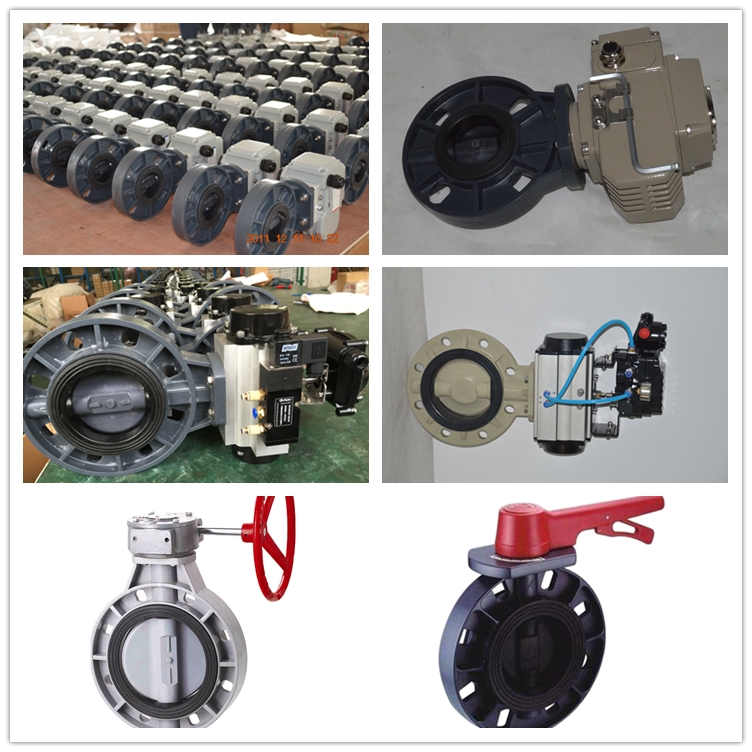
HVAC systems
HVAC (Heating, Ventilation, and Air Conditioning) systems are essential for maintaining comfortable indoor environments in residential, commercial, and industrial buildings. These systems play a crucial role in regulating temperature, humidity, and air quality, ensuring the well-being of occupants and the proper functioning of equipment. Butterfly valves are often used in HVAC systems due to their compact design, quick operation, and precise flow control capabilities. They provide efficient regulation of air or other gases throughout the system, enabling optimal temperature and air quality management. Moreover, butterfly valves offer low-pressure drops when fully open, ensuring minimal impact on the overall energy efficiency of the HVAC system. Their versatility in handling various fluid types, pressures, and temperatures makes them an ideal choice for applications such as chiller and cooling tower systems, air handling units, and heat exchangers. By incorporating butterfly valves into HVAC systems, building owners and operators can achieve greater control over indoor climate conditions while minimizing energy consumption and maintenance requirements.
Food and beverage industry
The food and beverage industry is a diverse and dynamic sector that encompasses the production, processing, and distribution of a wide range of consumable products. Hygiene, safety, and product quality are of utmost importance in this industry, as they directly impact consumer health and satisfaction. Butterfly valves play a crucial role in maintaining these standards by providing precise flow control during various stages of the production process. Their compact design, quick operation, and reliable sealing capabilities make them an excellent choice for handling liquids and semi-liquids, such as sauces, dairy products, and beverages. In addition, many butterfly valves used in the food and beverage industry are constructed with corrosion-resistant materials and feature sanitary designs to ensure easy cleaning and prevent contamination. These valves can be found in applications such as mixing tanks, product transfer lines, and filling machines, where their accurate flow regulation contributes to consistent product quality, reduced waste, and efficient operation. By incorporating butterfly valves into their systems, food and beverage manufacturers can maintain high standards of hygiene and quality while optimizing production processes and minimizing downtime.
Chemical processing plants
Chemical processing plants are complex facilities that involve the conversion of raw materials into valuable products through various chemical reactions and processes. These plants require precise control over fluid flow, temperature, and pressure to ensure safe and efficient operation, as well as to maintain the quality of the end products. Butterfly valves play a vital role in chemical processing plants due to their compact design, quick operation, and reliable sealing capabilities. Their versatility allows them to handle a wide range of fluids, including aggressive and corrosive chemicals, which are often encountered in this industry. Butterfly valves constructed from corrosion-resistant materials, such as stainless steel or special alloys, are particularly well-suited for these demanding applications. They can be found in processes such as mixing, transfer, and storage of chemicals, where their accurate flow control contributes to process optimization, reduced waste, and enhanced safety. By incorporating butterfly valves into their systems, chemical processing plants can achieve greater control over their processes while minimizing maintenance requirements and ensuring the consistent quality of their products.

Understanding Gate Valves
Gate valve are a type of valve commonly used for controlling the flow of fluids in various industries and applications. They function by using a gate-like mechanism, which can be raised or lowered within the valve body to either allow or obstruct the flow of fluid. This design provides a straight, unobstructed flow path when fully open, resulting in minimal pressure loss and making them ideal for applications where low-pressure drops and high flow rates are desired. Gate valves are known for their excellent shut-off capabilities, as the gate can create a tight seal with the valve seats when fully closed, preventing any leakage. These valves are best suited for on-off services rather than throttling applications, as their design does not allow for precise flow control. Gate valves come in various materials, sizes, and pressure ratings, making them suitable for a wide range of fluid types, temperatures, and pressures. They are commonly found in water and wastewater treatment plants, oil and gas pipelines, power generation facilities, and chemical processing plants. Understanding the characteristics and limitations of gate valves is crucial for selecting the right valve for a specific application, ensuring optimal performance and longevity of the system.
Definition and basic functionality of gate valves
Gate valves are a type of linear motion valve used primarily for controlling the flow of fluids in various systems and industries. The basic functionality of a gate valve involves a flat or wedge-shaped gate that slides vertically within the valve body to either open or close the fluid flow path. When fully open, the gate is completely retracted from the flow, providing an unobstructed straight-through passage with minimal pressure loss. This makes gate valves ideal for applications requiring high flow rates and low-pressure drops. Conversely, when the gate is lowered and fully closed, it creates a tight seal with the valve seats, effectively stopping fluid flow and ensuring reliable shut-off capabilities. Gate valves are best suited for on-off services, as their design does not allow for accurate flow control or throttling. Available in a variety of materials, sizes, and pressure ratings, gate valves can handle a wide range of fluid types, temperatures, and pressures, making them a versatile option for applications such as water distribution networks, oil and gas pipelines, and chemical processing plants. Understanding the definition and basic functionality of gate valves is essential for selecting the appropriate valve for specific system requirements and ensuring optimal performance.
Components of a gate valve
A gate valve is composed of several key components that work together to control the flow of fluids within a system. The primary component is the gate itself, which can be a flat or wedge-shaped plate that slides vertically within the valve body. The gate’s movement is controlled by a stem, which connects the gate to an external handwheel or actuator. As the handwheel or actuator is turned, the stem either raises or lowers the gate, opening or closing the fluid passage. Gate valves can have either a rising stem, where the stem moves up and down along with the gate, or a non-rising stem, where the stem remains stationary while the gate moves.
The valve body houses the internal components and provides a solid enclosure for the fluid flow path. It is typically constructed from materials compatible with the fluid type and application requirements, such as cast iron, stainless steel, or specialized alloys. Within the valve body, there are seats that create a tight seal with the gate when fully closed, preventing fluid leakage.
Other components of a gate valve include the bonnet, which seals the top of the valve body and provides access to the internal components for maintenance or repair, and various sealing elements, such as gaskets and packing, which prevent external leaks around the stem and bonnet. Understanding the components of a gate valve is essential for proper operation, maintenance, and troubleshooting, ensuring the longevity and efficiency of the valve within its intended application.
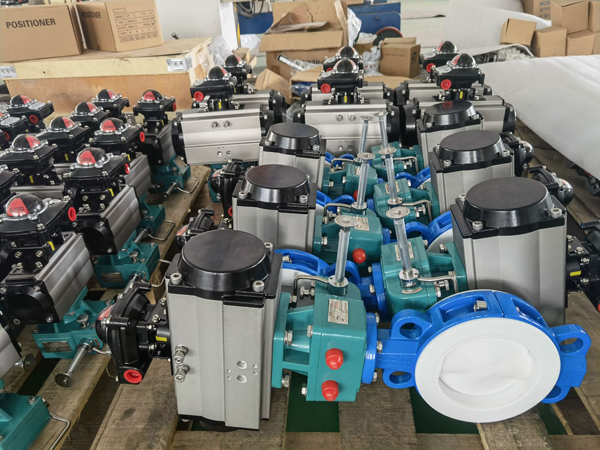
Advantages of using gate valves
Gate valves offer several advantages that make them a popular choice for controlling fluid flow in various applications and industries. One of the primary benefits is their ability to provide a straight, unobstructed flow path when fully open, resulting in minimal pressure loss and making them ideal for systems requiring high flow rates and low-pressure drops. This full-bore design also helps to reduce turbulence and erosion within the valve, contributing to a longer service life.Another advantage of gate valves is their excellent shut-off capabilities. When fully closed, the gate forms a tight seal with the valve seats, effectively stopping fluid flow and ensuring reliable isolation. This makes them particularly suitable for on-off services, where precise flow control or throttling is not required.
Gate valves are available in a wide range of materials, sizes, and pressure ratings, allowing them to handle diverse fluid types, temperatures, and pressures. This versatility makes them applicable across various industries, such as water distribution, oil and gas pipelines, power generation, and chemical processing.Furthermore, gate valves can be operated by a variety of actuation methods, including manual handwheels, electric actuators, and pneumatic or hydraulic systems, providing flexibility in meeting specific operational requirements. By understanding and leveraging the advantages of using gate valves, engineers and system designers can select the most suitable valve for their applications, ensuring optimal performance and reliability.
Applications Best Suited for Gate Valves
Gate valves are best suited for a variety of applications where reliable isolation and minimal pressure loss are crucial factors. One of the most common applications is in water distribution networks, where gate valves are used to manage the flow of water and enable the isolation of specific sections of the system for maintenance or repairs. Their ability to provide a straight-through flow path with low-pressure drop makes them ideal for maintaining efficient water flow in these systems. Similarly, in wastewater treatment plants, gate valves are often employed to control the flow of treated and untreated water, ensuring proper functioning of the plant while providing reliable isolation when needed.
In the oil and gas industry, gate valves play a critical role in pipelines and processing facilities, where they are used to manage the flow of various hydrocarbons, such as crude oil, natural gas, and refined products. Their excellent shut-off capabilities and compatibility with a wide range of materials make them suitable for handling these aggressive fluids, even under high pressures and temperatures.Power generation facilities, particularly those utilizing steam, also benefit from the use of gate valves. They are often installed in steam distribution lines and boiler feedwater systems to control the flow of steam and water, ensuring efficient operation while providing reliable isolation during maintenance or emergency shutdowns.
In chemical processing plants, gate valves are utilized to manage the flow of various chemicals and process fluids, including highly corrosive and abrasive substances. The availability of specialized materials, such as corrosion-resistant alloys, allows gate valves to withstand these harsh environments and maintain their functionality over time.Despite their limitations in precise flow control and throttling applications, gate valves remain a versatile and reliable option for many industries and applications where on-off service and dependable isolation are essential. By selecting the appropriate gate valve design and materials based on the specific requirements of each application, engineers and system designers can ensure optimal performance, safety, and longevity of their fluid control systems.
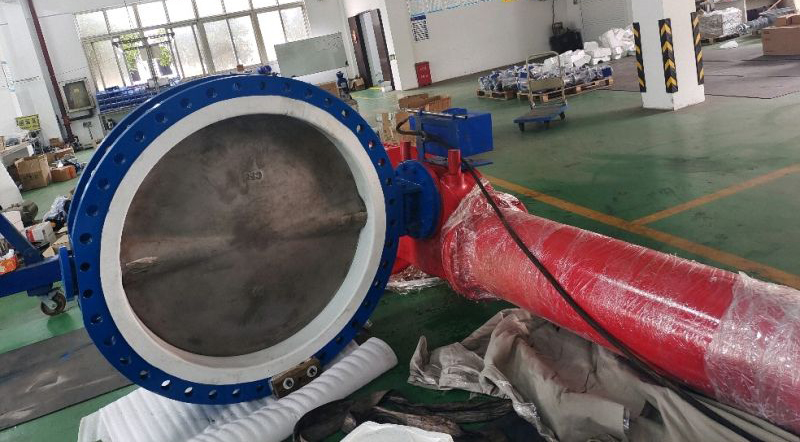
Oil and gas industry
The oil and gas industry is a crucial sector that plays a vital role in meeting the world’s energy demands, fueling economic growth, and driving technological advancements. Comprising of upstream, midstream, and downstream segments, this industry encompasses a wide range of activities, from exploration and extraction of hydrocarbon resources to transportation, refining, and distribution of petroleum products and natural gas. Operating under challenging conditions, such as extreme temperatures, high pressures, and remote locations, the oil and gas industry relies heavily on sophisticated technologies, specialized equipment, and skilled professionals to ensure safe, efficient, and sustainable operations. As global energy consumption continues to rise, the oil and gas sector faces significant challenges, including fluctuating market prices, increasing regulatory scrutiny, and growing environmental concerns. To address these issues, the industry is continuously evolving, adopting innovative solutions, and exploring alternative energy sources, all while striving to minimize its environmental footprint and enhance safety standards.
Water and sewage treatment plants
Water and sewage treatment plants are essential facilities designed to ensure the provision of clean, safe drinking water and the proper management of wastewater generated by human activities. These plants play a critical role in safeguarding public health, protecting the environment, and preserving valuable water resources. In water treatment plants, raw water from various sources, such as rivers, lakes, and groundwater, undergoes a series of physical, chemical, and biological processes to remove contaminants, pathogens, and impurities, resulting in potable water that meets stringent quality standards. On the other hand, sewage treatment plants are responsible for collecting, treating, and disposing of municipal and industrial wastewater, which contains organic matter, chemicals, and harmful microorganisms. Through a combination of physical, chemical, and biological treatment methods, these plants effectively remove pollutants and convert the wastewater into environmentally safe effluent that can be discharged back into water bodies or reused for various purposes, such as irrigation or industrial cooling. The efficient operation and maintenance of water and sewage treatment plants are crucial for ensuring the well-being of communities, promoting sustainable development, and preserving our planet’s precious water resources.
Power generation plants
Power generation plants are vital facilities that convert various energy sources into electricity to meet the ever-growing global demand for reliable and accessible energy. These plants utilize a diverse range of energy sources, such as fossil fuels (coal, natural gas, and oil), nuclear power, and renewable resources (solar, wind, hydro, biomass, and geothermal), to generate electricity through different processes and technologies. The electricity produced in these plants is then transmitted and distributed through interconnected grids to residential, commercial, and industrial consumers, powering modern life and driving economic development. Power generation plants are subject to strict regulations and standards to ensure efficiency, safety, and environmental compliance. As concerns about climate change, resource depletion, and energy security continue to rise, the focus in power generation has been shifting towards cleaner, more sustainable, and innovative technologies. Embracing renewable energy sources, enhancing energy efficiency, and investing in advanced power generation methods, such as combined-cycle plants and smart grids, are essential steps towards building a more sustainable, resilient, and low-carbon energy future for all.

High-pressure steam systems
High-pressure steam systems are widely used across various industries, such as power generation, chemical processing, and manufacturing, due to their ability to efficiently transfer heat and energy. These systems harness the power of steam generated at elevated pressures and temperatures, which allows for greater energy density and improved heat transfer capabilities compared to lower-pressure systems. High-pressure steam is often employed in applications like electricity generation through steam turbines, where it drives turbine blades to produce mechanical energy that is then converted into electrical power. Additionally, high-pressure steam is utilized in industrial processes requiring heating, sterilization, or chemical reactions, such as food processing, pharmaceutical production, and petrochemical refining. To ensure the safe and efficient operation of high-pressure steam systems, stringent design, construction, and maintenance standards must be adhered to, along with implementing proper safety measures, such as pressure relief devices and regular inspections. By leveraging the benefits of high-pressure steam systems, industries can optimize their energy consumption, improve process efficiency, and reduce overall operational costs.
Mining and mineral processing
Mining and mineral processing are essential industries that supply the raw materials needed for a wide range of applications, from construction and infrastructure to electronics and consumer goods. These sectors involve the extraction of valuable minerals and metals from the earth’s crust through various techniques, such as surface mining, underground mining, or solution mining. Once extracted, the ores undergo several stages of processing, including crushing, grinding, and separation, to extract and concentrate the desired minerals or metals. Advanced technologies, such as froth flotation, magnetic separation, and leaching, are employed to improve the efficiency and sustainability of these processes. The mining and mineral processing industries face numerous challenges, including fluctuating commodity prices, increasing environmental concerns, and stringent regulations aimed at minimizing the negative impacts of mining activities on ecosystems and local communities. As a result, there is a growing emphasis on adopting innovative approaches, such as automation, digitalization, and sustainable mining practices, to enhance operational efficiency, reduce environmental footprint, and ensure the long-term viability of these critical sectors.
Factors to Consider When Choosing Between Butterfly Valve and Gate Valve
When selecting the appropriate valve type for a specific application, several factors must be considered to ensure optimal performance, safety, and longevity of the system. Two common valve types, butterfly valves and gate valves, each offer their unique advantages and limitations, making them suitable for different scenarios. Butterfly valves are known for their compact design, lightweight construction, and lower cost compared to gate valves, making them an attractive choice for applications where space constraints and budget considerations are critical. Additionally, butterfly valves provide quicker actuation, allowing for faster opening and closing, which is beneficial in systems requiring frequent operation or emergency shut-off capabilities.
On the other hand, gate valves are recognized for their excellent shut-off capabilities and minimal pressure loss, as they provide a straight-through flow path when fully open. This makes them ideal for applications where maintaining efficient flow and reliable isolation are essential, such as water distribution networks, oil and gas pipelines, and high-pressure steam systems. Furthermore, gate valves are available in a wide range of materials and designs, enabling compatibility with various fluids, temperatures, and pressures, which may not be achievable with butterfly valves.
When choosing between butterfly valves and gate valves, it is crucial to evaluate the specific requirements of the application, including factors such as flow control, pressure drop, temperature, and media compatibility. For instance, if precise flow control or throttling is needed, a butterfly valve may be more suitable, as gate valves are primarily designed for on-off service. However, if the primary concern is reliable isolation with minimal pressure loss, a gate valve may be the preferred option. Ultimately, the selection process should involve a thorough assessment of the system’s needs, taking into account the advantages and limitations of each valve type, to ensure the most appropriate and effective solution is implemented.
Pressure and temperature requirements
Pressure and temperature requirements are critical considerations when designing and selecting equipment for various industrial processes and systems, as they significantly influence the performance, efficiency, and safety of the components involved. These parameters dictate the choice of materials, construction techniques, and safety features required to withstand the specific operating conditions, ensuring the system’s reliability and durability. In applications where high pressures and temperatures are prevalent, such as power generation, chemical processing, and oil and gas industries, it is essential to utilize robust materials like stainless steel, high-alloy metals, or specialized polymers that can resist thermal expansion, corrosion, and mechanical stresses. Additionally, components, such as valves, pipes, and fittings, must be carefully engineered and rated according to established industry standards, such as ASME and API, to guarantee their safe operation under the given pressure and temperature conditions. Proper monitoring and control systems should also be implemented to maintain these parameters within acceptable limits, preventing potential hazards, such as leaks, explosions, or equipment failures. By thoroughly addressing pressure and temperature requirements in the design and selection process, industries can optimize their operations, minimize downtime, and ensure the safety and well-being of personnel and the environment.
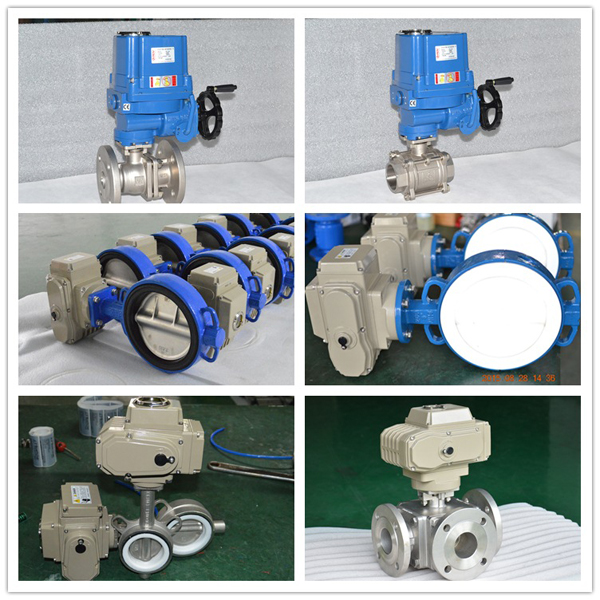
Fluid type and properties
Fluid type and properties play a crucial role in determining the design, material selection, and compatibility of equipment used in various industrial processes and systems. The nature of the fluid, be it liquid or gas, along with its specific properties, such as viscosity, corrosiveness, and abrasiveness, can significantly impact the performance, efficiency, and lifespan of components like valves, pumps, and pipes. For instance, fluids with high viscosity may require specialized pumping equipment to maintain adequate flow rates and minimize energy losses, while corrosive or abrasive fluids demand robust materials, such as stainless steel, high-alloy metals, or corrosion-resistant polymers, to withstand chemical reactions and wear over time. Furthermore, understanding the fluid’s behavior under different pressure and temperature conditions is essential for ensuring proper sealing and containment, preventing leaks and potential hazards. In the case of fluids that pose health or environmental risks, such as toxic chemicals or flammable gases, additional safety measures and monitoring systems must be implemented to safeguard personnel and the environment. By carefully considering the fluid type and properties when designing and selecting equipment, industries can optimize their operations, reduce maintenance costs, and ensure the reliability and safety of their systems.
Space constraints
Space constraints are a common challenge faced by engineers and designers when planning and implementing industrial systems, equipment, and infrastructure. The availability of limited space can significantly impact the choice of components, layout, and overall design, necessitating innovative solutions to optimize functionality and efficiency within the confined area. In such scenarios, compact equipment, such as butterfly valves, inline pumps, or modular process skids, may be favored over larger alternatives to minimize the spatial footprint while still delivering the desired performance. Additionally, creative engineering techniques, like implementing vertical or multi-level configurations, can help maximize the use of available space. Addressing space constraints also requires careful consideration of factors such as accessibility for maintenance, safety clearances, and potential future expansions, ensuring that the system remains adaptable and maintainable in the long run. By effectively managing space constraints through thoughtful planning and the selection of suitable components, industries can achieve operational efficiency and flexibility, even within the most restrictive environments.
Budget and overall cost
Budget and overall cost are critical factors that influence the decision-making process when designing, selecting, and implementing industrial systems and equipment. Balancing financial constraints with the need for reliable, efficient, and safe solutions requires careful assessment of various options and their associated costs, including initial capital expenditures, operational expenses, and long-term maintenance requirements. In some cases, opting for more affordable components, such as butterfly valves or off-the-shelf equipment, may be a viable choice to meet budgetary limitations, provided they satisfy the system’s performance and safety criteria. However, it is essential to consider the total cost of ownership, which encompasses not only the initial investment but also factors like energy consumption, maintenance, and potential downtime over the system’s lifespan. Investing in higher-quality materials, advanced technologies, or energy-efficient solutions may result in higher upfront costs but can yield significant long-term savings, ultimately proving to be more cost-effective. By thoroughly evaluating budget constraints and overall costs, industries can make informed decisions that optimize their operations, minimize expenses, and ensure the sustainability and profitability of their projects.
Maintenance requirements
Maintenance requirements play a pivotal role in the design, selection, and implementation of industrial systems and equipment, as they directly affect operational efficiency, reliability, and the overall lifespan of the components. Regular maintenance is crucial for ensuring the optimal performance and safety of elements such as valves, pumps, and pipes, while also mitigating potential failures, leaks, or hazards. When assessing maintenance needs, it is essential to consider factors like component accessibility, ease of servicing, and the availability of spare parts, which can help minimize downtime and simplify maintenance tasks. Choosing low-maintenance materials or designs, such as corrosion-resistant alloys or self-lubricating bearings, can reduce maintenance intervals and related costs. Furthermore, incorporating advanced monitoring and diagnostic technologies allows for predictive maintenance strategies, facilitating early detection of potential issues and timely intervention before they escalate into more significant problems. By thoroughly addressing maintenance requirements during the design and selection process, industries can enhance operational efficiency, extend equipment longevity, and maintain a safe and productive working environment for personnel.
Conclusion
In conclusion, butterfly valves and gate valves are two widely used types of valves in various industries, each with their unique advantages and applications. Understanding the specific requirements of your application and considering factors like fluid type, pressure and temperature conditions, space constraints, budget, and maintenance requirements will help you determine the most suitable valve for your project.Butterfly valves are best suited for applications requiring flow regulation, quick shutoff, or where space is limited. Their compact design, lightweight construction, and ease of operation make them an ideal choice for HVAC systems, water treatment plants, and chemical processing facilities. Additionally, their relatively lower cost and simpler maintenance requirements make them an attractive option for budget-conscious projects.
On the other hand, gate valves are perfect for applications that demand minimal flow restriction and infrequent operation. Their ability to provide a tight seal and handle a wide range of fluids, pressures, and temperatures makes them well-suited for use in oil and gas pipelines, power generation plants, and other high-pressure applications. Though they may have higher initial costs and more complex maintenance needs compared to butterfly valves, their robustness and longevity can make them a cost-effective solution in the long run.Ultimately, the decision between using a butterfly valve or a gate valve depends on the specific needs of your application. It is essential to consult with experienced engineers and valve manufacturers to help you make the right choice, ensuring the optimal performance, safety, and efficiency of your system. By carefully evaluating the advantages and limitations of each valve type and considering the factors discussed in this blog post, you can confidently select the most suitable valve for your project, contributing to its long-term success and sustainability.
Recap of the key points discussed in the blog post
In this blog post, we delved into the key factors to consider when choosing between butterfly valves and gate valves for various applications. We discussed the importance of understanding fluid type and properties, space constraints, budget and overall cost, and maintenance requirements when making a decision. Butterfly valves are ideal for flow regulation, quick shutoff, and space-limited applications, while gate valves excel in providing minimal flow restriction and handling high-pressure environments. By carefully evaluating these factors and consulting with experienced professionals, you can make an informed decision on the most suitable valve for your project, ensuring optimal performance, safety, and efficiency in your system.
Importance of selecting the right valve for the specific application
Selecting the right valve for a specific application is of paramount importance to ensure the optimal performance, safety, and efficiency of an industrial system. The correct valve choice not only facilitates smooth operation but also extends the lifespan of the equipment, minimizing the risk of failures, leaks, or other potential hazards. Moreover, the appropriate valve selection can help reduce maintenance requirements and associated costs, leading to long-term savings. By carefully considering factors such as fluid properties, pressure and temperature conditions, space constraints, budget, and maintenance needs, industries can make informed decisions that contribute to the success and sustainability of their projects. Ultimately, selecting the right valve for a specific application plays a crucial role in achieving operational efficiency and ensuring a safe working environment for personnel.

Encourage readers to consult with professionals when choosing valves for their projects
We strongly encourage readers to consult with experienced engineers and valve manufacturers when selecting valves for their projects. These professionals possess the knowledge and expertise required to assess your application’s unique requirements and recommend the most suitable valve type based on factors such as fluid properties, pressure and temperature conditions, space constraints, budget, and maintenance needs. By engaging with experts in the field, you can ensure that the chosen valve meets performance and safety criteria, ultimately contributing to the long-term success and sustainability of your project. Additionally, consulting with professionals can help you avoid costly mistakes and potential operational issues, resulting in a more efficient, reliable, and safe industrial system that benefits both your company and its employees.



